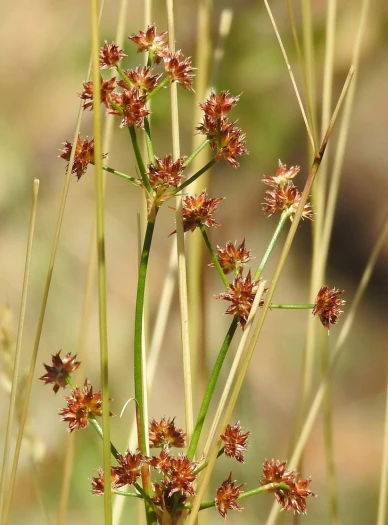Desfontaines’ Rush
(Juncus fontanesii)
Desfontaines’ Rush (Juncus fontanesii)
/
/

Ángel Fernández Cancio
CC BY 4.0
Image By:
Ángel Fernández Cancio
Recorded By:
Copyright:
CC BY 4.0
Copyright Notice:
Photo by: Ángel Fernández Cancio | License Type: CC BY 4.0 | License URL: http://creativecommons.org/licenses/by/4.0/ | Rights Holder: Ángel Fernández Cancio | Publisher: iNaturalist | Date Created: 2020-07-07T12:32:55-07:00 |

Estimated Native Range
Climate Requirements for Celina, Texas
| This Plant | Your Site | Plant Suitability for Your Location | ||
|---|---|---|---|---|
| • Precipitation | 8" - 44" | 39" | Aquatic | Aquatic |
| • High Temp. | 70°F - 96°F | 95°F | Your summer temperatures are normal for this plant. | Excellent |
| • Low Temp. | 23°F - 49°F | 32°F | Your winter temperatures are normal for this plant | Excellent |
This plant should grow well at your location with about N inches per year (Y minutes per month) of irrigation.
Summary
Juncus fontanesii, commonly known as Desfontaines’ rush, is a perennial herb native to wet meadows, marshes, and along the edges of freshwater bodies in the Mediterranean and West-Asian regions. It is often found in regions from Italy eastwards, including the presence of sub-species pyramidatus and kotschyi. This rush typically forms sprawling clumps with stems that can resemble those of Juncus articulatus. The inflorescence is characterized by a lax arrangement of spherical heads of flowers, which are not particularly showy but have an architectural appeal. The tubular leaves are distinctive with inner cross divisions, and the fruit capsule is notable for being longer than the tepals and gradually tapering to a point.
Desfontaines’ rush is appreciated for its textural qualities and is used in water gardens, rain gardens, and naturalistic plantings, particularly in wetland restoration projects. It thrives in full sun to part shade and requires consistently moist to wet soil conditions. While it is not a high-maintenance plant, it is important to ensure that it does not dry out. It is not known for significant disease or pest problems, but it can spread in ideal conditions and may require management to keep it in check.CC BY-SA 4.0
Desfontaines’ rush is appreciated for its textural qualities and is used in water gardens, rain gardens, and naturalistic plantings, particularly in wetland restoration projects. It thrives in full sun to part shade and requires consistently moist to wet soil conditions. While it is not a high-maintenance plant, it is important to ensure that it does not dry out. It is not known for significant disease or pest problems, but it can spread in ideal conditions and may require management to keep it in check.CC BY-SA 4.0
Plant Description
- Plant Type: Grass
- Height: 2-4 feet
- Width: 1-2 feet
- Growth Rate: Moderate
- Flower Color: N/A
- Flowering Season: Summer
- Leaf Retention: Deciduous
Growth Requirements
- Sun: Full Sun, Part Shade
- Water: High
- Drainage: Slow, Standing
Common Uses
Erosion Control, Low Maintenance, Water Garden
Natural Habitat
Wet meadows, marshes, and freshwater body edges in the Mediterranean and West-Asian regions
Other Names
Common Names:
Scientific Names: Juncus fontanesii, Juncus echinuloides, Juncus repens, Phylloschoenus lagenarius
GBIF Accepted Name: Juncus fontanesii